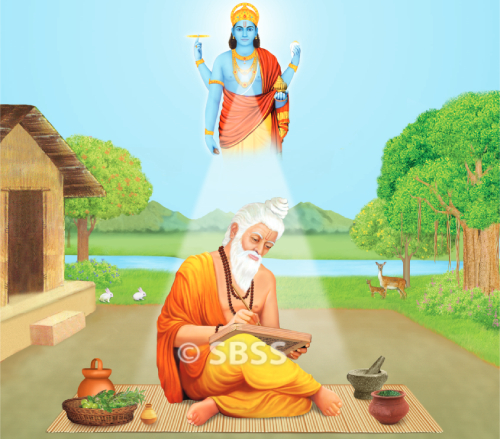Ayurveda for a healthy life ! – 4/2023
Importance of good health as per Ayurveda

1. Various methods of processing food
Except fruits and some vegetables and tubers, used as salad, we use most food items only after cooking. Most of the food items available in Nature have to be processed before cooking.
Cooking, cutting, sprouting, fermentation, drying, milling, hand pounding and parboiling are the commonly used methods of processing food.
1A. Cutting and trimming : Vegetables are washed with water and then peeled and cut before cooking. If soaked in water, nutrients such as Vitamins B and C can be lost in water.
1B. Sprouting : It improves the nutritive value of food and digestibility. vitamin C and riboflavin are synthesized during sprouting but cooking destroys most of the vitamin C. According to Ayurveda, a person with weak eyesight, should not consume sprouted legumes.
1C. Fermentation : Commonly used fermented articles are curd, idli (Prepared from udid and rice) and dhokala (Prepared from gram flour). Fermentation improves the digestibility of food as per modern medical science and fermentation adds flavour to it. Fermented food should be avoided by individuals with hyper-acidity, peptic ulcer, rheumatism and diseases of the Pitta dosha.
1D. Hand pounding & milling : Milling improves digestibility by discarding the outer layer of coarse fibre. Unfortunately, vitamins B1, B2, nicotinic acid, calcium and iron are lost during milling. Hence, polished rice and maida (Milled wheat flour) should be avoided, as far as possible.
1E. Parboiling : Rice is first soaked in water, steamed and then dried. By this process the nutrients get infused into the rice grains. Hence, subsequent milling does not destroy vitamin B and minerals, to that extent. It has greater resistance to insects and fungus.
1F. Cooking : Cooking makes the food easily digestible. It adds flavour and taste to the food. By killing germs, it makes food safe for consumption. The various methods used for cooking are –
1. Roasting on fire e.g., roasted meat, roasted corn
2. Boiling in water e.g., cooking rice
3. Frying in oil or ghee e.g., pakoda, papad
4. Steaming e.g., idli, modak
5. Pressure cooking
While cooking, the particle of food slightly separate from one another as heat expands and separates the individual molecules. During boiling and frying, the particles of water, oil or ghee interpolate between the food particles and make food easily digestible.
Some minerals such as sodium, potassium, chlorine and water soluble vitamins such as vitamins B and C are lost if the water in which food is cooked is thrown away, as per modern medical science. Hence, while cooking one should use just enough quantity of water.
Extra water should be added to preparations such as soups, vegetables, etc. Tubers such as potatoes should be boiled with their skin intact. The skin should be removed only after the
cooking is over. Rice should be washed minimally, to maintain its nutritive value and hand pounded rice should be used, rather than polished rice.
It is preferable to consume steamed vegetables rather than boiled ones, as boiling leads to a loss of carotene, i.e., vitamin A to the extent of 75%. Food should be cooked in as short a time
as possible, so as to reduce the destruction of nutrients, e.g., vitamins present in it. This can be achieved by using a pressure cooker.
Addition of soda-bicarb facilitates cooking and preserves the colour of food, but it destroys most of the vitamins B1 and C. Biotin, a vitamin of the B complex group, is present in a large amount in egg yolk. It is inactivated by a substance called avidin (antivitamin), present in egg albumin. When an egg is cooked, avidin is completely destroyed, so that biotin is available for absorption.
Some pulses and legumes such as soya bean and Bengal gram and the egg of a duck contain substances which inhibit secretion of trypsin, an enzyme that is essential to digest proteins. Cooking destroys the trypsin inhibiting substance.
Exposure of food to light destroys riboflavin and Vitamin C. Food ingredients such as tamarind which are highly acidic, have a preservative effect on vitamins, particularly on vitamin C. Cooking in a pressure cooker comparatively preserves food value and saves a lot of time and fuel.
Proteins in meat, milk and eggs can be easily digested after cooking. After cooking, the covering of cereals break open as the inner starchy substance swells and the cereals become soft. Hence, they can be easily digested. Boiled carrots and vegetables are easily digested, compared to raw carrots and vegetables. Raw vegetables lead to abdominal distension, rather than cooked vegetables. Fatty substances are not affected by cooking.
Cooking is an art. A good cook can easily prepare tasty and attractive dishes, even from cheap food items. Overcooking
should be avoided, as besides spoiling the taste and flavour, it destroys the nutritive value of food as well.
One should always consume freshly cooked food as after a few hours or days, it becomes rancid or putrefies.
2. Preservation
The common methods of preserving food items are as follows
2A. Drying : Germs grow faster on wet food items than dry ones. Hence, cereals and pulses are preserved by drying them in the sun. Fruits such as dates, anjir, badam (Almonds), etc. as well as vegetables, are preserved by drying. Even fish, eggs and milk are preserved by drying.
2B. Exposure to smoke : Fish and meat are preserved by this method.
2C. Addition of salt : Since ancient times, food items are preserved by adding salt to them, e.g., fish, vegetables, pickles, etc.
2D. Kitchen : The kitchen should be clean, well lit and well equipped with clean cooking utensils. The food items and water used should also be clean. The servants and the cook should follow the rules of hygiene and should be trustworthy.
3. Some study as per modern Science
3A. Vitamin C is a water-soluble and temperature-sensitive vitamin, so is easily degraded during cooking, and elevated temperatures and long cooking times have been found to cause particularly severe losses of vitamin C
3B. Vitamin D, A and K do not get destroyed completely on heating.
3C. Even though the B-group vitamins are found in many foods, they are water soluble and are generally quite delicate. They are easily destroyed, particularly by alcohol and cooking.
3D. A balanced diet is rich in minerals and vitamins
3E. The nutrient loss for commercially-dried foods varies between 30 – 80% for vitamin C and 10 – 50% for vitamin A. Loss depends on many factors, including storage time, drying temperature, and dry time.
3F. Freeze drying halts that degradation and keeps the vitamins intact.
3G. Since pressure cooking doesn’t require a much higher temperature and shortens the cooking time, there is less time for nutrient loss.
3H. The retention of thiamine, riboflavin, niacin and folic acid in parboiled rice is greater than that of polished or hand pounded rice.
3I. Parboiling improves digestibility
3J. Milling of grains results in major losses (in descending order) of thiamine, biotin, vitamin B6, folic acid, riboflavin, niacin, and pantothenic acid.
3K. Brown rice is rich in vitamin B1. When brown rice is polished, rice loses many vitamins and minerals including vitamin B1 through the bran.
Vitamin E, which is an antioxidant that helps to protect flour from oxidation, deteriorates once milled, especially in the moist conditions.
3L. The other vitamins such as vitamin – A, D, E, and K are all fat soluble vitamins. Fat-soluble vitamins are not destroyed by normal cooking methods but cooking food at high temperature destroys vitamin E.
3M. Most fermented foods contribute bacteria that have a potential probiotic effect, easier to digest and improves the availability of nutrients.
3N. Sprouts are rich in a number of important nutrients. They generally contain high levels of folate, magnesium, phosphorus, and protein. Sprouted grains may have less starch and be easier to digest than regular grains.
3O. If pathogenic bacteria are present in or on seed, they can still grow to high levels during sprouting.
3P. Trimming, peeling and cutting, used to remove inedible or undesirable portions from food, will obviously lead to nutrient loss. There is often a higher concentration of some nutrients in the outer portions of fruits and vegetables.

 Radiant Thoughts of Sachchidananda Parabrahman (Dr) Jayant Athavale
Radiant Thoughts of Sachchidananda Parabrahman (Dr) Jayant Athavale Law banning Conversion of Religion is against Individual Freedom : Babbles Former Judge S Muralidhar
Law banning Conversion of Religion is against Individual Freedom : Babbles Former Judge S Muralidhar Editorial : Khalistan, Balochistan and Pakistan
Editorial : Khalistan, Balochistan and Pakistan After India becomes a ‘Hindu Rashtra’, Russia will embrace Hinduism and spread it globally : Nostradamus’ Prophecy
After India becomes a ‘Hindu Rashtra’, Russia will embrace Hinduism and spread it globally : Nostradamus’ Prophecy ‘Halt Public Spending on Aurangzeb’s Tomb, Prioritise Maharashtra’s Heritage’ : HJS
‘Halt Public Spending on Aurangzeb’s Tomb, Prioritise Maharashtra’s Heritage’ : HJS Noise Pollution, Loudspeakers, and the Law
Noise Pollution, Loudspeakers, and the Law